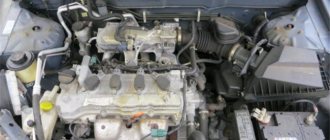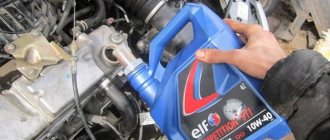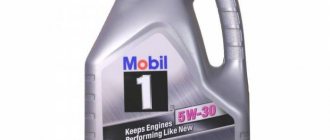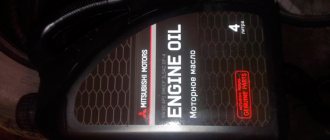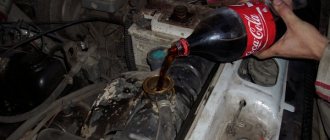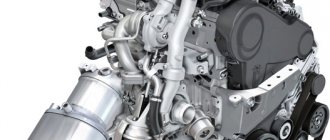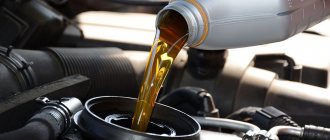How to change engine oil correctly
Any car engine uses several working fluids that perform specific tasks. One such liquid is oil.
Lubrication performs several functions in the power plant:
- reduces friction between engine components;
- removes heat from them;
- and also washes engine parts, thereby removing debris and wear products from working surfaces, on which the service life of the motor directly depends.
Oil is a rather complex liquid in composition, consisting of a mineral or synthetic base, a mixture of them (so-called semi-synthetic oils), as well as a package of additives that give the lubricant certain properties.
During operation, the oil gradually exhausts its resource and loses its properties. And since this fluid plays an important role, it requires periodic replacement.
Official dealers who carry out maintenance under warranty change the oil at every maintenance specified in the regulations.
But not everyone’s car is serviced at official service stations, so car owners have to independently monitor the condition of the engine and change the oil after a certain period of use of the car.
Express engine oil change: why it can be dangerous
Hi all! How about discussing with me such a topic as express engine oil change?! I think it will be interesting for many motorists. Some will learn for the first time about the essence and features of quick replacement. Others will be able to share their own experiences and personal opinions on this matter. Just leave your feedback in the comments.
Every car enthusiast knows very well that any car with an internal combustion engine has a number of working fluids. The main one is rightly considered to be motor oil. It is this that requires periodic mandatory replacement.
There is a category of drivers who prefer to change the oil themselves. Moreover, this is far from the most complicated procedure, which does not require special equipment. But when they are too lazy to do such things, many look on the map of Moscow, cities like St. Petersburg, Petrozavodsk, Samara or Yekaterinburg for the nearest replacement points. This is already a hardware change, within which special equipment is used. Is express replacement good and what do you need to know about it? Now we'll find out.
Oil change intervals
The frequency of oil changes is indicated in the accompanying technical documentation. vehicle documentation. The lubricant recommended for use is also indicated there.
The service life of the oil depends on the composition and operating characteristics of the vehicle. Thus, mineral oil can work up to 10 thousand km, and after that it must be replaced. But this type of oil is practically not used; either semi-synthetic or synthetic oil is poured into the car. These types of oils can already work up to 15 thousand km.
But there is one important feature. Long mileage when changing oil is possible if the car is operated in “greenhouse” conditions. That is, the operating conditions of the lubricant must be almost ideal, which in reality is very rare. Temperature changes, increased loads, driving without warming up, and downtime in traffic jams affect the lubricant, which reduces its service life. Under normal operating conditions, the engine oil should be changed every 10-12 thousand km, but if the car is subjected to harsh operating conditions, then the frequency is reduced to 5-7 thousand km.
If the oil is not changed, it will gradually lose its quality - the rubbing surfaces will be insufficiently lubricated, which will lead to rapid wear of the components.
Draining oil through the dipstick tube
Changing the oil through the dipstick (it should be clarified that this is how the oil is only removed, filling occurs through the filler neck) is done using a special installation. It has a fairly simple design and may look different depending on the manufacturer.
To describe it in general terms, the solution consists of a container for receiving used oil, a tube with a hose and a pump that creates a vacuum in the container. By the way, there are also more complex, professional devices designed for use in car repair shops. But the operating principle remains the same.
The pumping process occurs due to an artificially created pressure difference inside the engine and inside the installation itself. The procedure goes as follows:
- The installation tube is inserted into the dipstick tube. She sinks to the very bottom;
- a pressure difference is created;
- oil is pumped out;
The speed of oil pumping depends on the installation itself, as well as on the viscosity and temperature of the liquid itself. But, on average, this rate is about 1 liter per three minutes. Thus, if the engine is filled with 5 liters of oil, the process of removing it will take 15-20 minutes.
For many motorists, pumping oil out of the engine through a tube may seem unusual and cause mistrust. However, car service employees who practice this procedure confirm its effectiveness and benefits.
The advantages of tube pumping are:
- The used oil is completely removed, while with a normal drain, up to 10-15% of the “waste” remains in the engine;
- This method makes it possible to change the oil in cases where it is not possible to change the oil as standard or is difficult for various reasons;
- Time saving;
In fairness, it is necessary to point out some disadvantages that may make car enthusiasts think about how best to drain the oil from the engine, standardly or using an installation.
We also recommend reading the article on how to flush the engine when changing the oil. From this article you will learn about various methods and methods for flushing the engine and its oil system before changing the lubricant, in case of switching from one type of oil to another, etc.
There are also disadvantages of this method:
- “Heavy” residues and clots of oil mixed with metal particles, dirt, burnt grease, etc. may remain in the pan;
- Quite a high cost of installation for self-replacement or the cost of the procedure in a car service;
- Simultaneously with the replacement, an inspection of the lower part of the car is not carried out; the presence of faults diagnosed by chips in the oil may not be detected in a timely manner.
What work will be required?
Changing the engine oil is one of the most frequently performed engine maintenance operations. It is not complicated, even a novice car owner can do it on their own. It doesn't take much to do it:
- open-end wrenches;
- special wrench for unscrewing the oil filter;
- container for collecting waste;
- new oil;
- oil filter;
- funnel (cut neck of a plastic bottle);
- rags.
When switching to another type of lubricant, it is recommended to additionally flush the engine. Also, this operation is performed during the first oil change on a car purchased second-hand, because it is not known for certain what oil the previous owner used.
Therefore, let’s look at how to change the oil using the Chevrolet Lanos as an example.
Step-by-step instruction
Having prepared the necessary tools and devices, you can begin to work. For this:
1. Warm up the engine to the optimal temperature for 10 minutes. You can also change the oil immediately after a trip, but you need time to cool the engine, otherwise you may get burned. It is necessary to warm up the car so that the oil “lifts” all the settled contaminants and also becomes more liquid.
2. We place the car on the inspection hole to make it easier to get to the traffic jam. You can, of course, do without a hole, but access to the drain plug will not be very convenient.
3. Remove the cap from the oil filler neck. This will ensure faster drainage of the lubricant. If this is not done, the oil will flow out slowly because a vacuum will form inside the engine, since air will not penetrate inside the engine.
4. Wipe the drain plug and the adjacent surfaces of the pan with a rag.
5. Take a container to collect waste (it can be an old oil canister with the side cut out) and place it under the drain plug.
6. Use a wrench to remove the drain plug (clockwise). Once broken, the plug can be unscrewed easily even by hand. When unscrewing, we hold it, because when completely unscrewed, the pressure of the oil can knock it out of your hand, and then you will have to “catch” it from working off.
How to change oil with engine flushing
As for replacing the lubricant with flushing the engine, it is carried out in approximately the same way as described, but you will have to perform some additional steps. Also, replacement will require a special flushing fluid.
If the oil is changed with washing, then there is no need to immediately remove the used filter. After draining the waste, we put the drain plug in place, and there is no need to change the gasket on it. Then fill the engine with flushing fluid. The amount of oil required for flushing is usually indicated by the manufacturer on the packaging.
After refueling with flushing, start the engine and let it run for a while (5-15 minutes). We turn off the engine, take another container for collection and drain the flushing liquid from the installation (it is drained in the same way as the waste).
And only after washing, we change the filter and plug gasket, fill in new oil, doing this as described above.
That’s the whole sequence of changing the engine oil and the procedure is suitable for any car.
Video: Changing engine oil.
How does a standard oil change work?
The standard procedure for changing oil in a car engine takes place in three stages:
- removing old oil;
- engine flushing;
- adding fresh oil;
At the first stage, the used oil is drained through a special hole in the engine sump. It is more convenient to do this on a lift, overpass or inspection pit. However, some cars have ground clearance that allows you to drain it anyway.
The second stage is that about another liter of clean oil is poured into the engine (the so-called “spill” flushing), after which the engine is cranked once with the starter. Next, the drain plug is unscrewed again, and the remaining oil is given time to drain from the pan. And finally, at the third stage, the required volume of fresh oil is filled.
This method is used by most car enthusiasts, but draining oil from the engine through the crankcase has one significant drawback: the old oil is not completely removed. A certain amount of it (up to 500 ml) remains in various technological cavities and channels, which is subsequently mixed with fresh oil.
There are two main ways to avoid this phenomenon. The first is that after draining the used oil through a hole in the sump, the filter is removed and a special device is connected in its place. It pumps compressed air, which squeezes out the remaining oil from the channels and cavities, which is also drained through a hole in the pan. After this, the standard procedure described above follows. There are also other ways to drain oil from the engine.
Watch the video
During vehicle operation, engine oil oxidizes and burns out under the influence of high temperatures. In addition, the oil becomes contaminated with metal microparticles formed in the engine as a result of engine wear. Therefore, approximately every ten thousand kilometers the engine oil must be changed. To do this, you must first completely drain the old used oil from the engine.
How to drain engine oil
Even a novice car enthusiast can drain the oil on his own. This work, although dirty, is very simple and does not require special knowledge and skills. In order to drain the oil from the engine, you will need a minimum set of tools and materials:
- a long ring wrench with a 17 - 19 mm head (depending on the size of the plug in the drain hole);
- an old basin, an unnecessary pan or any other container with a volume of at least five liters;
- long rubber gloves;
- hard brush;
- a piece of rag.
Operating procedure.
- The oil must be drained from a hot engine immediately after driving the car. If the engine is cold, start the car and warm the engine to operating temperature at idle speed.
- Drive the car onto an overpass or into a viewing hole in the garage. Turn off the engine and put the car on the handbrake.
- Open the hood. Unscrew the oil filler cap and remove it. Wipe the neck and lid with a rag.
- Take a basin, gloves, wrench, brush and rags and get under the car.
- Use a brush and rag to clean the drain plug located in the oil pan.
- Put on gloves, move the basin closer and start unscrewing the cap with a wrench. Do this very slowly and carefully! The engine oil has a temperature of about 80 o Celsius! If you move carelessly, you can get seriously burned.
- When you feel that the plug is almost out, continue unscrewing it with your right hand, and take a basin in your left hand and bring it under the drain hole.
- After the oil rushes down, gently lower the basin to the floor. If, through carelessness, you dropped a cork into a basin, do not rush to urgently fish it out. Nothing will happen to her. Wait for the oil to cool, and only then remove the plug from the basin. Check to see if the copper gasket has come off.
- Wait until the oil has completely drained from the engine. This takes about twenty minutes.
- After this, wipe the drain bolt and screw it into the neck.
The transmission oil is drained from the gearbox in the same way. The only difference is that the oil in the box is changed much less frequently than in the engine.
How to completely get rid of old oil?
01 August 10:00 2014 by Suprotec
120
The life of fuel in an internal combustion engine is simple and fleeting: it enters the cylinder, burns, and literally flies out into the chimney. The fate of motor oil is much more interesting and, ultimately, more important for the engine. Oil is not only a layer for rubbing parts, but also an integral working part of some mechanisms (such as hydraulic valve compensators) and a cleaning agent. It is the oil that removes metal wear products, dust particles, and a certain amount of unburned fuel from the engine.
The oil honestly takes on pressure, temperature loads, and pollution over many hours of operation and 10-15 thousand kilometers, providing the engine with comfortable operation and pleasure for the car owner. With such active and responsible service, it is not surprising that the oil gradually loses its working properties. The acid number of the oil increases, which means it causes corrosion of metal parts. The degree of contamination increases and the viscosity increases. And finally, the moment comes when the oil needs to be changed.
At its core, the oil change operation is simple: the engine is started for a few minutes, then stopped, and the hot oil is drained or pumped out. It would seem that all that remains is to add fresh oil and the procedure is completed. However, it's not that simple.
It is almost impossible to drain all the old oil from the engine. It remains on the walls of the engine, in cavities, channels, and so on. The remainder of the old one can be up to 15-20% of the total volume, depending on the design and condition of the engine. It is not difficult to guess that when mixed with fresh oil, this residue immediately reduces its service life and performance properties. The acid number of this mixture and viscosity are noticeably different from those of pure oil. Oil deposits also remain in the engine - particles of contaminants on the walls of parts and oil channels. The general condition of the oil is as if the car had already driven a couple of thousand kilometers.
It's like frying meat in a frying pan without washing it from the previous fish. The meat will be flavorful. But it’s much easier to clean a frying pan than an engine.
To clean, sometimes the engine is turned on for a minute in “dry” mode. This allows you to “knock out” a certain amount of leftovers. This approach improves the situation, but not significantly. In addition, running the engine dry, even for a short time, may be unsafe for it, especially if the engine is old.
To solve the cleaning problem, human genius came up with several more ways. One of them is that after draining the old oil, the engine is filled with special flushing oil and allowed to run for about 20 minutes. And only after that fresh oil is added. Tests show that these products really help maintain parameters of new oil such as acid number and viscosity. The number of metal particles and the total mass of deposits in the pan are reduced. However, there is still a long way to go until the engine is completely cleaned.
Another method is the so-called short flushes. These are products that are added before the old oil is drained and the engine is allowed to idle for 10 minutes. After changing the oil, its properties were close to the results of using flushing oil. But in the pan there were fragments of deposits removed from the engine by detergent components, but not dissolved. This poses the potential risk of blocking the oil passages and resulting serious problems in engine operation.
Another cleaning method is “long” rinsing. This class of products is added to the old oil approximately 200 km before the change. Test results show that this method is quite effective in combating deposits and in maintaining the original performance properties of fresh oil. However, you need to start worrying about this in advance! In addition, “long” flushes can be dangerous if the engine oil is in critical condition, there is a possibility that the engine simply will not last an additional 200 kilometers.
Comparative data on oil tests after various methods of flushing the engine in the form of long tables with various numbers can only be useful to truly deep experts on the issue. For all those who would like to minimize their concerns about their favorite vehicle, the conclusions and recommendations based on the measurement results, which are given below, will be most useful.
The first good news is this: when changing the oil, the engine does not need to be flushed if you carefully follow the oil change schedule specified in the vehicle documentation. In this case, the old oil is still quite far from the critical state and mixing with fresh oil does not spoil it dramatically.
Conversely, if the car has a significant overmileage in relation to the service life of one oil fill, it is highly recommended to flush the engine.
Washing the engine is also useful for those who use an unknown type of oil. This is the case, for example, when the car was purchased on the secondary market. Cleaning is also useful when the new oil is of a higher class than the previous one. If the car was filled with mineral oil, and you plan to use synthetics, then to preserve its performance properties, primarily viscosity, it makes sense to fill it into a clean engine.
Engine flushing is also recommended for vehicles with recorded cases of engine overheating. Although it would be even more useful to consult a specialist.
In a word, the brief conclusion of this review may come as a surprise to car enthusiasts: the instructions for using the car are written to the point, and not just to give car repair shops more opportunities to collect money for maintenance. It's better to change your oil regularly, just like brushing your teeth and taking a shower!
On the topic of:
- A new project on the Nissan website will join the list...
- The Verkhovna Rada proposed a complete ban on imports...
- Mercedes is preparing the first fully automated plant
- Infiniti has published the first teaser of the concept...
- Volkswagen will release an all-electric T-Rug crossover
Article “tagged” as: motor oil
Categories:
BlogsPartners
How to drain oil from a gearbox
In order to drain the oil from the gearbox, you will need wrenches, rags, gloves and a container to collect the oil.
Operating procedure
- The oil from the gearbox, as well as from the engine, is drained when the engine is hot. In this case, it becomes less viscous and flows out of the box faster and easier. If the engine has cooled down while parked, warm it up at idle speed to operating temperature.
- Drive the car onto an overpass or place it in a viewing hole. Turn off the engine, put the car on the handbrake, and for greater reliability, support the wheel with a brick.
- Pull out the dipstick designed to monitor the oil level in the gearbox. Old VAZ models do not have such a probe. Instead, there is a filler plug that must be unscrewed.
- Go under the car, put on gloves and, using the appropriate size wrench, begin to unscrew the drain plug.
- When the plug is almost unscrewed, place a container under the drain hole to collect used oil and remove the plug completely.
- Wait until all the oil has drained from the gearbox. This usually takes no less than a quarter of an hour.
- After the last drops of oil have flowed down, wipe the drain plug with a soft cloth and screw it back into the neck tightly.
Sometimes, when adding new oil, too much of it is inadvertently poured into the engine. In cases where the oil level on the dipstick exceeds o, it becomes necessary to drain excess oil from the engine without unscrewing the plug in the oil pan. You can do this as follows.
- Pull the dipstick out of the hole.
- Insert the IV tube deeply into this hole.
- Attach the other end of the tube tightly to the spout of a large medical rubber bulb (or to a syringe without a needle).
- Using a bulb (or syringe), suck out a small portion of the oil and pour it into a jar.
- Check the oil level with a dipstick.
- Repeat step 4 if necessary.
How to drain excess oil from a car engine without lifting the car
Recently I had the need to go on a long trip by car. Moreover, this was very unexpected, and the brothers were needed several hours in advance.
And before a long trip, the car should be checked. Since I did maintenance just a couple of months ago, I only checked the tire pressure, spare tire, oil level and other technological fluids, and a set of tools in case of an emergency.
Your conditions
Engine oil loses its properties over time, so it must be changed every 10,000–15,000 km. The easiest way to do this is at a car service center, but you can also save money by doing the work yourself. For the lucky owners of a garage with an inspection hole, to drain the oil, you just need to unscrew the drain plug in the engine sump. Anyone who does not have access to such a hole can use a pump to pump out the oil through the dipstick hole.
Let us note right away: such a device will help you out only if you can reach the oil filter, the replacement of which is necessary when filling in new oil, from above. If in your car you can only replace the filter from the bottom, the oil pump will not make your job much easier. After all, you still have to crawl under the car.
How to pump oil out of an engine
There are two ways to pump out motor lubricant from the main power unit. Both methods are good, but car services, as practice shows, use only one, since it is proven and does not cause any problems. So, let's look at the detailed instructions on how to drain the lubricant from the engine.
Option 1 - traditional
Drain the oil from the filler plug, which is located on the engine oil pan. This method is used when changing the oil or, if necessary, draining excess oil from the engine. The technological process is quite simple:
- As with any repair, it is first recommended to disconnect the negative terminal from the battery. Of course, car enthusiasts don’t do this, relying on luck.
- We install the car so that there is access from below, that is, a pit or a lift will do.
- We substitute containers from 5 to 14 liters, depending on the classification and capacity of the cylinder block.
- We unscrew the drain plug and wait until the oil flows out of the engine.
Option 2 - play with straws
The second option, of course, is not the most convenient or the best, but it is rarely used. So, the motorist must insert a tube through the filler neck and connect a small pump or use a suction the old fashioned way to pump out excess oil from the engine.
Important! You should not resort to this method, since the entry of motor lubricant into the human body can lead to the fact that he ends up in the hospital with poisoning.
This method is quite common when oil is poured into the engine. Pouring lubricant and then pumping it out is not particularly convenient, and can also become unpleasant. Therefore, when pouring liquid, it is better to underfill a little rather than overfill.
Before you start
Secondly, the electric pump does not operate dry, so you need to remove the plugs on the holes for the tubes and pour 40–50 ml of oil into the device using a syringe.
Thirdly, the tube that goes into the oil dipstick hole has a diameter of 6 mm, while the diameter of the dipstick tube on some machines may be smaller in diameter. Simply put, not every engine can be connected to an electric pump. Among them, for example, is the 1.8-liter Lada Vesta engine, on which we initially wanted to do all the work.
Paradoxically, thanks to this, our experiment only became “cleaner”: we decided to drain the oil using an electric pump on the same car on which we tested the vacuum pumping installation some time ago. This is a Chevrolet Aveo.
Conclusion
In many cases of vehicle operation, it may be necessary to drain the oil from the internal combustion engine. Of course, not a single manufacturer recommends carrying out this process yourself, but only at a car service center. Still, car enthusiasts do everything themselves, with their own hands, to avoid additional waste, since the pricing policy of most car services leaves much to be desired.
At the same time, we should not forget that incorrectly replacing the lubricant will entail a lot of troubles, so it is better to pay extra for a replacement than to “end up” with a major overhaul of the “heart” of the machine.
Pure experiment
Insert the tube into the hole for the dipstick and connect it to the pump. On the other side we fix the second tube - to drain the oil. We lower its second end into a 5-liter plastic drinking water bottle (a transparent container allows you to control the volume of drained working fluid). We make sure that the pump is turned off, then connect the terminals of the device to the car battery, observing the polarity.
Turn on the pump and start pumping. The oil rises through a tube inserted into the dipstick hole, passes through the device and flows out of the second tube into a plastic container.
After a few minutes, the sound made by the oil pump motor changed as the engine became easier to operate. This means the oil has run out. Let's verify this by moving the tube inserted into the probe hole. If the sound of the pump does not change, turn off the device.
Examination
To understand how effectively the electric pump coped with its task, lift the car on a lift and unscrew the drain plug in the pan. The oil flows out quite intensively. During our last experiment, when we used a vacuum installation for similar work, this did not happen.
The conclusion is obvious: you should not change the engine oil yourself using an electric pump. And although the device is interesting, it clearly needs improvement.
What's left
We completely drained the oil from the engine, replaced the oil filter and filled it with fresh oil. The result of the experiment did not satisfy us - an impressive amount of old oil remained in the engine.
Despite the fact that an experiment with an electric pump cast doubt on the effectiveness of this device, it is possible to change the engine oil in a garage without an inspection hole. If you use a vacuum installation for this. It costs twice as much as an electric pump (2,600 rubles versus 1,300–1,350), but has two significant advantages over it: a vacuum unit, which pumps out the oil almost completely, is more efficient and versatile, since it allows it to be drained from the engine even through a narrow hole for the oil feeler gauge
What's the result?
It is quite obvious that changing the oil is a necessary procedure and should be performed as carefully as possible. Each method has its own strengths and weaknesses.
By the way, many experienced car enthusiasts recommend alternating between classic and manual oil changes, which partially eliminates the disadvantages of both one and the other methods.
Types and principle of operation of flushing liquids. In what cases is it necessary to flush the engine? When you should not use an engine flush before changing the oil.


